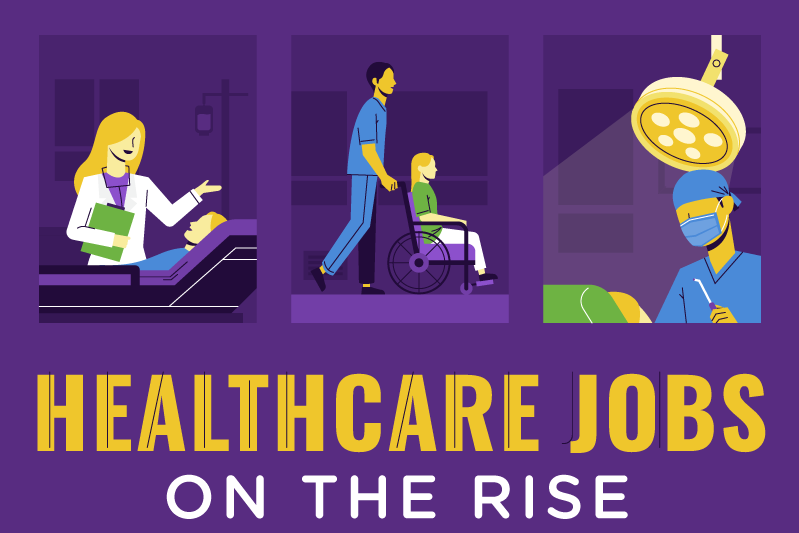[vc_row][vc_column][vc_column_text]It’s one of the basic human rights: high-quality, affordable, and accessible healthcare. But does everyone in the US get it?
According to the latest healthcare statistics, there are still many Americans who go without medical care due to rising health-related costs or lack of insurance.
What does it take to improve the healthcare system? First, data and trends need to be analyzed and weaknesses and strengths identified.
That’s where these stats come in. The latest research gives all stakeholders a better understanding of the US health system, paving the way to the best changes and improvements.
The Top 10 Most Important Healthcare Statistics to Take into Account
- The US spent $3.65 trillion on healthcare in 2018.
- Health care expenditures account for 17.9% of the US’s entire economy.
- $2.16 billion was spent on hospital care and medical professionals alone.
- Administrative costs account for almost 30% of healthcare spending.
- 84.3% of US adults had contact with a healthcare professional in 2018.
- 30.4 million US citizens didn’t have insurance in 2018, health insurance statistics indicate.
- 17.2% of Americans were covered by Medicare in 2017.
- 70% of all Medicare beneficiaries are enrolled in Medicare Part D.
- Medicaid covers approximately 20% of Americans.
- The healthcare industry is the biggest employer in the US.
Take a look at the following infographic and more stats after the jump to get a full grasp on this rapidly growing industry![/vc_column_text][/vc_column][/vc_row][vc_row][vc_column][vc_single_image image=”822″ img_size=”full” alignment=”center”][/vc_column][/vc_row][vc_row][vc_column][vc_column_text]
How Much Is Spent on Healthcare in the US?
1. In 2018, US residents’ healthcare expenditures totaled $3.65 trillion.
(Axios)
Healthcare statistics from 2018 show that US healthcare costs are the same size as Canada and Spain’s combined GDPs. And if these numbers aren’t upsetting enough, keep in mind that US healthcare spending increased by 4.4% since last year.
2. US healthcare expenditures account for 17.9% of the country’s GDP.
(Statista, Fortune)
Estimates are that healthcare costs will continue to go up, and by the year 2027, healthcare will make up a shocking 19.4% of the country’s GDP, US healthcare statistics from 2018 indicate.
3. US healthcare costs by far exceed that of other countries in the developed world.
(PGPF, OECD)
The US per capita spending was $11,121 in 2018, a world apart from the OECD average. Switzerland—where healthcare costs per capita are $7,300—is ranked second, while the average for all OECD countries was only $5,300 per person.
Sadly, the outcome doesn’t match the investment. Healthcare statistics by country reveal that the US actually shows worse results in life expectancy, infant mortality, and diabetes rates than other developed nations that spend less on medical care.
4. $2.16 billion was spent on hospital care and medical professionals alone.
(Axios)
Hospitals, doctors, and clinical services accounted for 59% of total costs, a slight increase from 2017.
The cost of prescription drugs, on the other hand, rose to 3.3% in 2018 from 2017’s 0.4%. Still, the largest increase was noted in health insurance spending, which rose 7.7% in 2018.
5. Administrative costs account for almost 30% of healthcare spending.
(Econofact)
Judging by health care spending statistics, it’s safe to describe US spending on the related administrative costs as excessive.
With 15% of all healthcare costs spent on billing and insurance-related services alone and a quarter of the healthcare workforce engaged in administrative tasks, the US spends more on “back-end” functions that direct patient care.
In fact, experts cite this as one of the reasons behind expensive healthcare in the US.
6. A visit to the ER without insurance can cost between $150 and $3,000.
(The Balance, Healthcare.gov)
The cost of medical procedures without insurance can be incredibly high. For instance, a broken leg can generate bills in the amount of $7,500, not to mention more serious injuries and illnesses. For some critical cases, patients can spend $20,000 in the ER.
7. Americans pay an average of $30,000 to stay in the hospital for 3 days.
(Debt.org, Business Insider, Healthcare.gov)
Going to the ER is expensive, but hospital stays are even worse. Data shows that the average hospital cost per day in 2018 amounted to around $3,949. In addition, some estimates show that the added cost of hospital stays exceeds $384.5 billion a year overall.
So who pays the bill? Medicare pays most of it, or around 46%, Medicaid chips in with 17%, and private insurance covers 28% of the cost.
8. Heart surgery can cost up to $170,000.
(Debt.org)
A hip or knee replacement can set you back $40,364 and $35,000, respectively. The cost of medical treatment in the USA is definitely something to think about.
With basic procedures running up medical bills, as well as the fact that cardiovascular diseases cost the US over $350 billion annually, the idea of needing surgery is terrifying from a financial point of view.
Even with good coverage, there are still out-of-pocket expenses of 20% or higher, as well as additional costs such as anesthesia, medication, and pre-surgery hospitalization. No wonder people go bankrupt from medical bills.
9. Medicaid individual spending increased by 1.1%.
(Axios)
In addition, per-person Medicare spending went up 3.1% in 2018. According to the health care facts and statistics from 2018, patients paid 4.5% more in 2018 under private insurance even though the enrollment rate in private plans stayed the same.
Access to Healthcare in the US
10. 87.6% of US citizens had a usual place they could go to for their medical care in 2018.
(CDC, NCHS)
This percentage is slightly lower than the 88.3% estimate for 2017. On the other hand, 4.8% of US citizens didn’t have access to medical care at all due to the high costs.
11. 84.3% of US adults had contact with a healthcare professional in 2018.
(NCHS)
The US healthcare facts and statistics confirm that Americans are good about going to the doctor.
Estimates for 2018 show that 883.7 million US citizens visited a physician, with over half visiting their primary care physician.
That’s 277.9 visits per 100 patients. The percentage is even higher for kids. In 2018, 93.6% of children in the US had contact with a healthcare professional.
Health Insurance Statistics and Facts in the US
12. 30.4 million US citizens didn’t have insurance in 2018.
(NCHS, The Commonwealth Fund)
This number remains unchanged from the previous year. However, it has significantly decreased from 48.6 million in 2010 when major changes were introduced in the healthcare system under the Affordable Care Act.
More people may have insurance today, but 87 million, or 45% of adult citizens aged 19–65, were underinsured last year. What does underinsured mean? A person is considered underinsured if their out-of-pocket costs are over 10% of their household income.
13. Coverage gaps have shortened since 2010.
(The Commonwealth Fund)
Obamacare statistics show that not only has the number of uninsured adults decreased since the Affordable Care Act was passed, but 61% of US adults said they’d been uninsured for 6 months or less. In addition, 31% had a coverage gap of one year or longer.
For comparison, in 2012, before major changes were made by the ACA, 57% of US citizens had a gap in insurance coverage lasting for longer than one year.
14. In 2018, 13.3% of adults under 65 were uninsured, the US healthcare statistics from 2019 reveal.
(NCHS)
68.9%, or 136.6 million US citizens under the age of 65 paid for private insurance, with 4.2% covered by private health insurance through the Health Insurance Marketplace.
45.8% of those aged 18–64 were enrolled in a high-deductible private health plan, an increase from the previous year’s 43.7%.
15. 41.8% of children had public insurance in 2018.
(NCHS)
By contrast, only 5.2% of children were uninsured and over half (54.7%) were covered by private insurance, the National Center for Health Statistics informs.
16. The number of uninsured adults increased in Ohio from 9.4% to 12.7%.
(NCHS)
The largest disparity when comparing uninsured rates by state from 2017 to 2018 is shown in Ohio, while the percentage of uninsured adults under 65 is more or less the same in other states for that time period.
Texas has the highest rate of uninsured adults: 26.4% in 2017 and 25% in 2018.
Medicare Statistics
17. 17.2% of Americans were covered by Medicare in 2017.
(Statista, 2018 Medicare Trustees Report)
This translates to 58.4 million beneficiaries of the federal social insurance program, 49.5 million of whom were enrolled on account of age, while the remaining 8.9 million were enrolled due to various disabilities.
18. Total Medicare costs made up 2.9% of the country’s GDP in 2018.
(2018 Medicare Trustees Report, PGPF)
The previous year’s Medicare expenditures accounted for 3.7% of the GDP, healthcare statistics from 2017 tell us.
Faster growth rates are expected for the next 30 years. In fact, Medicare costs should make up 5.9% of the country’s economy by 2048.
19. Medicare Part A covered 41% of benefit payments in 2018.
(Statista, Kaiser)
Medicare Part A, or hospital insurance, covers Medicare inpatient care in a hospital, skilled nursing facility, or at home. Part A is primarily tax-funded.
(CMS, Kaiser)
Medicare Part B covers physician services, hospital services, medical equipment, and other health services not covered by Medicare Part A.
72% of Medicare Part B funds come from general revenue, while only 26% were supplied by premiums.
21. Out-of-pocket spending for those on Medicare amounted to an average of $5,806 in 2016, healthcare statistics indicate.
(Kaiser)
Of this sum, around 45% of the spending was on Medicare premiums, while more than half (55%) was spent on medical and long-term care facilities and services.
22. A third of all Medicare beneficiaries are enrolled in Medicare Advantage plans.
(NEJM)
Between 2018 and 2019, the number of Medicare Advantage beneficiaries grew by 1.6 million, or 8%. Both the enrollment and growth rates have remained steady since 2017, Medicare enrollment statistics indicate.
More and more people, especially seniors, are opting for the Medicare Advantage program due to the extra benefits, as well as the limitations of out-of-pocket expenses.
23. Maine and West Virginia had the highest percentage of Medicare beneficiaries in 2017.
(Statista)
24.1% of the total population of Maine and 23.6% of West Virginia residents were Medicare beneficiaries. What state has the highest number of Medicare beneficiaries?
That would be California, with 5.8 million Medicare enrollees, medicare facts reveal.
24. 70% of all Medicare beneficiaries are enrolled in Medicare Part D.
(Kaiser)
This means that 45 million people use the Medicare Part D drug benefits. It’s interesting to note that three companies (UnitedHealth, Humana, and CVS Health) cover almost 60% of all Part D enrollees.
Medicaid Healthcare Statistics and Facts
25. Medicaid covers approximately 20% of Americans.
(Kaiser)
This amounted to more than 75 million low-income US citizens in 2017. 43% of all these Medicaid enrollees were children, while seniors and people with disabilities made up around a quarter of all enrollees.
26. Total Medicaid spending in 2018 amounted to $593 billion.
(Kaiser, Healthinsurance.org)
62.5% of expenses were covered by the government, and 37.5% were financed by the states that have accepted the program, statistics in healthcare reveal.
To date, 33 US states and the District of Columbia have accepted Medicaid, while at least three are in the process of approving the expansion.
Generous government funding under Obamacare has allowed Medicaid to cover even more citizens from vulnerable groups.
27. Since the expansion, Medicaid enrollment increased by 14.7 million.
(MACPAC)
The highest increases in enrollment rates were registered in the Medicaid expansion states, which ranged from 5.7% in Illinois to a whopping 99.1% in Kentucky.
According to US healthcare statistics, only Vermont noted a decline, which was 4%.
28. Medicaid almost matches private insurance healthcare facilities in terms of quality and access.
(Commonwealth Fund)
A 2017 survey indicates that 91% of Medicaid enrollees have a consistent source of medical care (whereas 93% of privately insured adults and 77% of uninsured citizens have care access).
What’s more, 57% of Medicaid users rated their healthcare services as good or excellent, unlike the 52% of the US citizens with private insurance and 40% of uninsured patients who had positive views on healthcare quality in the US.
Healthcare Industry Statistics
29. Healthcare is the biggest employer in the US.
(The Atlantic, BLS)
In 2017, health and education services surpassed both retail and manufacturing regarding the sector’s total number of employees.
And this isn’t just a passing trend. Jobs in healthcare are expected to grow at 14% within the next 10 years.
This means that around 3.4 million new jobs will be created in healthcare and social assistance.
30. Healthcare industry turnover is the second-highest in the US.
(NSI Nursing Solutions)
Health care facts in 2018 reveal that hospital turnover was 19.1%, up by 0.9%. The turnover for registered nurses increased to 17.2% (the same as in 2015), making this the highest turnover for nurses in the past 10 years.
This is a serious issue as every percent change in RN turnover can either save or cost a hospital an average of $328,400.
31. Physicians see an average of 20 patients a day.
(Healthcare Finance News, AAPL)
Typically, physicians spend 51 hours a week working, healthcare statistics show. Almost a quarter of that time is spent on administrative tasks and paperwork. No wonder two-thirds of physicians say they feel burned out.
32. Physicians make good money in the US.
(WebMD)
In 2019, the salaries of physicians went up to $313,000 from $299,000 in 2018 with orthopedists reporting the highest earnings in the field, at an average of $482,000 a year.
They are closely followed by plastic surgeons who make $471,000 annually.
33. More than one in four doctors in the US was born in another country, some of the more interesting facts about health care reveal.
(Reuters)
A 2018 study showed that around 29% of physicians, 24% of dentists, and 16% of nurses were born outside of the US.
What’s more, 20% of pharmacists and over 23% of home health, psychiatric, and nursing aides came from other countries.
Experts say that if foreign healthcare professionals weren’t allowed to train in the US, there would be staffing shortages, particularly in low-income areas.
In fact, estimates show that there will be a shortage of 121,900 physicians by 2032, both in primary and specialty care.
FAQ
What is the United States healthcare system?
First and foremost, the US doesn’t have a universally accessible healthcare system. Americans are covered by public and private health insurance with employers paying the biggest share of medical coverage.
Medicaid and Medicare, the two government-funded programs, provide coverage to the elderly and the most vulnerable groups of citizens.
Nevertheless, despite expansion in these programs and improvements in the United States healthcare system, there is still a large percentage of Americans who are uninsured or have no access to healthcare due to high costs. Not only that, but the US health system is falling behind other high-income countries in quality, while costs continue to go up.
Why is US healthcare so expensive?
One of the main reasons is the burden of administrative costs and the cost of drugs. Actually, the health care facts indicate that the US government could save up to $116 billion in 10 years if it provided low-income beneficiaries of Medicare Part D the same prices as other Medicare enrollees.
Another factor that drives up costs is the practice of so-called defensive medicine. Lawsuits are pretty common in the US, and doctors tend to order expensive tests just to cover all the bases. This expense, which was estimated at $650 billion in 2010, is paid by all Americans.
What are the sources of health statistics?
Health statistics can come from many sources, such as surveys, medical and vital records, or peer-reviewed literature. Medical records provide data on diagnoses and procedures and help measure and analyze trends. However, they can often be misinterpreted, plus they only offer information on people who have received medical care.
The relevant types of health statistics that vital records provide focus on cause of death, which gives professional insight into rare and fatal diseases. Meanwhile, claims data comes directly from healthcare providers and includes a large amount of information that can be analyzed and studied.
All of these sources are important in helping us analyze the past, present, and future of healthcare in the country.
Why are statistics important in the healthcare field?
Health stats are an essential tool in understanding risk factors and devising protective measures. They also help researchers, medical professionals, and patients track and monitor diseases and their impact on certain communities. Last but not least, stats are utilized to evaluate the quality of healthcare and provide the best possible solutions.
How much does the average person spend on medical care?
Healthcare costs for the average US household amounted to almost $5,000 per person in 2018. Compared to 30 years ago, this is an increase of 101%. It’s no surprise that individual healthcare expenditures are rising when it’s estimated that an average US citizen paid around $3,400 on insurance alone in 2018. Even though employers pay for a large share of premiums, the average US citizen still spent $1,242 of their own funds on healthcare last year.
Why is it important to have health care?
The ethical aspect is one of the obvious reasons why providing healthcare to everyone is a must. The entire purpose of medicine is to ensure that people can lead healthy, happy, and productive lives. Which brings us to another point. Having a nation of healthy and able-bodied citizens boosts the economy and is cost-effective, too.
Final Thoughts
People will always need medical care. This statement has never been truer than today, when people live longer and are more aware of the significance of getting continuous and quality medical attention.
Judging by the latest healthcare statistics, access to medical care has improved considerably, but more needs to be done to bring the US healthcare system to a more affordable and, frankly, higher level.
Sources:
- 2018 Medicare Trustees Report
- American Association for Physician Leadership
- Axios
- BLS
- BLS
- Business Insider
- CDC
- Commonwealth Fund
- Debt.org
- Econofact
- Fortune
- HealthCare.gov
- Healthcare Finance News
- Healthinsurance.org
- Kaiser Family Foundation
- Kaiser Family Foundation
- Kaiser Family Foundation
- Kaiser Family Foundation
- MACPAC
- NCHS
- NCHS
- NCHS
- NEJM
- NSI Nursing Solutions
- OECD
- Peter G. Peterson Foundation
- Peter G. Peterson Foundation
- Reuters
- Statista
- Statista
- Statista
- The Atlantic
- The Balance
- The Commonwealth Fund
- WebMD
[/vc_column_text][/vc_column][/vc_row]



